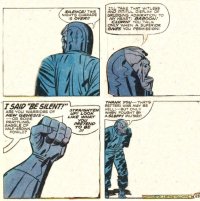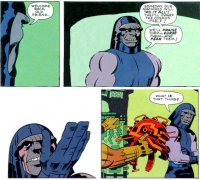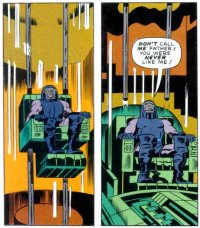


Kirby & Simon’s Best
June 5th, 2009 Posted by david brothersThe Best of Simon and Kirby
Joe Simon & Jack Kirby, edited by Steve Saffel
240 pages, 9″x12 1/4″
I’m a Kirby fan.
It’s obvious if you know me, I think. I love the Captain America & the Falcon stuff he did, I love the New Gods, and I think that his character design is top notch. Of course, all of my favorite Kirby work was created after he’d become Jack “King” Kirby. This was late era Kirby, if you go by the length of his career.
Early Kirby, the raw stuff from the beginning of his career, is mostly a mystery to me. I have one of Marvel’s Visionaries hardcovers that collects a lot of it, like the Two-Gun Kid stuff, and it’s pretty fascinating. A lot of what made Kirby Kirby was there in the text, though in an unpolished form.
Titan Books recently released The Best of Simon and Kirby, a volume collecting a lot of those issues that I’ve never seen. I’ve got to say that they did a stellar job with it. It’s oversized (essentially a coffee table book), printed on non-glossy paper, and a real work of art. The extra size really lets you get into the art, which is part of the point of this book.
Joe Simon and Jack Kirby were a team for years, and worked in a variety of genres. This volume collects stories featuring superheroes, criminals, and (the deep, dark secret of Kirby & Simon) stories from the original romance book, Young Romance. I’d known that Kirby had a hand in popularizing romance comics, and it’s nice to finally get a chance to read them.
The Best of Simon and Kirby also reprints a couple of titles from DC and Marvel. Captain America, The Vision (the old one), Sandman, and a Boy Commandos tale wrap up the Big Two work in this book.
I really, really like this book. It’s a historical collection, but the way it’s presented is as more of a conversation piece. Each genre gets a chapter break in the form of a short essay that also doubles as a biography of the careers of each man. It’s conversational in tone, and detailed enough to educate you about a time you rarely hear about. It makes it easy to burn through the book, too, since it provides an easy stopping point for each genre. I spent a couple of days knocking out a series of stories before bed.
The most striking thing about this book, I think, is how un-Kirby a lot of it looks. The thick lines and insane layouts that dominated Kirby’s later work are present in the occasional story here, but most of the work isn’t as undeniably “Kirby” as, say, the Fourth World volumes. My first thought is to say that it was Joe Simon’s inking that makes it look so different, but something I keep forgetting is that a lot of these stories were over twenty years old before Kirby put pen to paper on Fantastic Four #1. Over the course of twenty or thirty years, anyone’s style would, and should, change around a little bit.
The Best of Simon and Kirby is forty bucks, which is a little pricey, but worth every penny to Kirby and Simon fans, or even people interested in comics history.

Black History Month ’09 #14: Simple, Ain’t It? But Quite Clever.
February 14th, 2009 Posted by david brothersI don’t read comics because of Jack Kirby, but I do enjoy them more than I would because of the ones he created.
There are a few hero pairs out there, groups like Superman/Steel, Captain America/Falcon, Iron Man/War Machine, Scott Free/Shilo Norman, Captain Marvel/Monica Rambeau, Hal Jordan/John Stewart, and maybe a few others. Generally, I’m talking about either the black replacement or the black sidekick.
 Most authors tend to set up a situation in which one hero is better than the other, sometimes even to the point where one hero defers to the other just based on stature. Other times, the black heroes are left to languish for years. John Stewart is kind of clearly the red-headed step child of the Green Lantern Corps, being the only one without regular panel time. Shilo Norman was in limbo for years and Monica Rambeau still hasn’t gone anywhere. It’s almost always a little off balance.
Most authors tend to set up a situation in which one hero is better than the other, sometimes even to the point where one hero defers to the other just based on stature. Other times, the black heroes are left to languish for years. John Stewart is kind of clearly the red-headed step child of the Green Lantern Corps, being the only one without regular panel time. Shilo Norman was in limbo for years and Monica Rambeau still hasn’t gone anywhere. It’s almost always a little off balance.
Kirby’s treatment of Captain America & the Falcon was pretty amazing. Even though Captain America is an icon and a war hero, their relationship was one based purely on friendship. Falcon wasn’t consumed with hero-worshipping Cap, nor was he just on sidekick status. They were just friends. They would hang out, do things together, and get into adventures. It was a buddy movie, rather than anything involving sidekicks.
I mentioned it last year, but Kirby invented Gabriel Jones, Black Panther, Flippa Dippa, Vykin the Black, Black Racer, Princess Zanda, and Mr. Miracle over the course of his career. I’m sure that he created more, but these characters alone are impressive. What Kirby did was push forward a diverse cast of characters. He was a guy who did the stories he wanted to tell, and those stories weren’t all-white.
In an email, Tucker Stone from The Factual Opinion said this to me:
Wouldn’t it be better if you hired a writer who pitched a black story because that’s the story he wanted to tell? I flat out refuse to believe that there’s nobody with one. There’s a million douches with fantasy stories about Power Girl. There’s somebody with a black Firestorm story. Wouldn’t you just be starting from a cleaner point? A point where you say, hey, this guy is black so fucking what. I have a story I want to tell. Instead, you get: this guy’s black now. Figure it out and make it work.
That’s what Kirby did. He wasn’t given an order to create a Black Superman or Black Firestorm. He just wrote about black characters because he thought it’d be a good story, not because there was a need for a New Diversity Initiative. No one in a board room was sitting over his shoulder, telling him to make his books ethnic or urban or whatever fake word we are using now to mean “black.” He wasn’t trying to fix anything. He wasn’t trying to be anti-racist.
He just did it because he wanted to.
That’s how it should work.

More on Space Ships
August 10th, 2008 Posted by david brothersI got a link on io9 about my post on afro futurism. I’d have responded there, but I can’t comment or whatever, so I’ll just do it here. Hope those guys come through and find this!
Also, the OP says the essay refers to “alternate personas of the Wu-Tang Clan” when it only refers to one alternate persona of one member, the RZA, or Bobby Digital, who is an unusual guy even within his group. Just because he’s black doesn’t mean he’s not a NERD. If one displays nerdy tendencies, does the nerd identity supercede the racial identity? I think so. It’s obviously not a true dichotomy, but while it’s somewhat tenuous to identify certain behaviors as ‘racial,’ it seems universally easy to identify certain behaviors as ‘nerdy.’ Nerdiness, to me, is color-blind.
One more point I’d like to make, black Americans don’t “not have a past” just because their histories are soiled with the slave trade. They have a very distinct past, and an incredibly strong source of identity (adversity). They’re not building anything out of nothing, they’re building everything out of a ton.
-telor, io9
I only mentioned one member, which is a fair point, but I could’ve easily mentioned Ghostface, who flips from Tony Starks to Pretty Tony and back again with regularity. One’s a flamboyant superstar, the other a drug dealing psychopath. Method Man’s Johnny Blaze isn’t an accident, and ODB made a career out of flipping pseudonyms and gimmicks, though to be fair, all those gimmicks at least partially involved being high on PCP. RZA isn’t all that unusual in the Wu, I think. Even Inspectah Deck plays around with being more than he is at times.
Kanye’s Glow in the Dark tour is him speaking with aliens who believe he’s the greatest rapper alive. Pharrell/Chad/Shay’s N.E.R.D. stands for No one Ever Really Dies and pushes nerd chic, as well as being on top and better than everyone else. Black Star’s sophomore album was supposed to be called Blackstar Galactica. Cannibal Ox’s Cold Vein advanced the idea of poor blacks being pigeons, with phoenixes being the end result of life as a pigeon.
Yes, black people can be nerds. Only an idiot would deny that. However, in the context of what I’m talking about and the past seventy or so years of black history, it is fair to suggest that since these traits line up with the greater context, that they are representative of something more.
In a very real way, blacks don’t have a past, particularly in comparison to America at large. A lot of people can trace their pasts back to Sweden, or Britain, or the Lakota nation, or X province in China, or whatever. For most blacks, that isn’t an option. We can’t trace our lineage back X generations, or show off our family crest, or whatever.
No one really wants to say “I dunno,” when someone asks “Where’s your people from?” you know?
Obviously, there are exceptions. There’s that gene tracing thing that’ll give you a general area of where you’re from, but for the average man? Not an option. It’s a recent development, anyway.
I kind of feel that my point still stands.
Thanks to everybody who has read and linked it around. Tell your friends!

I Call My Brother “Son” ’cause He Shine Like One
August 7th, 2008 Posted by david brothersThis bit of audio here is important. It’s from DC’s Final Crisis Management panel from San Diego Comic-con 2008. Thanks to Jamie Coville for the mp3 of the panel.
[MEDIA not found]The bit I want to talk about:
The whole idea with Mister Miracle, Mister Miracle was supposed to be a book where everyone was black and that was the idea. I wanted to do like, Metron as Sun-Ra. He’d sit in this big Sun-Ra chair with mirrors and stuff.
But, it wasn’t drawn that way. And when they drew the second issue, they drew the homeless New Gods as white guys, don’t ask me why. ’cause everyone in that book was supposed to be black characters ’cause I wanted the whole thing to be based on Shilo Norman and his world. But, those guys shouldn’t be white, sometimes things just happen, artists tend to draw white guys.
Before I go in, I should probably explain some things about myself.
It’s fair to say that I’m under-educated. My college career was derailed around two months before it really got going, and I’ve been off-track ever since. I went from almost being a Buckeye to being whatever this is. It sucked, if you were wondering.
I eventually got serious about school, starting caring again, and flexing my underachieving muscles. Kanye West dropped his College Dropout album and I hated on it originally. “Telling kids to drop out of college?” I thought. “Way to go, Kanye. I thought you were supposed to be smart.” I mean, here’s a bit from his song “School Spirit:”
Told ’em I finished school, and I started my own business
They say, ‘Oh you graduated?’
No, I decided I was finished
So, yeah, a few years later and I’m pretty much officially a college drop out with a job that pays better than anything I’d have gotten fresh out of college.
The point of this is that I’m not exactly trained. Almost everything I know, I learned because I wanted to or because I experienced it. I can’t cite sources or trace lineages for ideas, but I know a little bit about a little bit. I’m smart enough to be able to form arguments and talk about them intelligently. I’m not Encyclopedia Brown, is my point. Pardon my poor phrasings or ignorance.
What’s this got to do with black New Gods?
Grant Morrison came very close to writing one of the best stories about the black experience. I can’t speak to whether it was on purpose or not. My gut says “Yes, to an extent,” so I’ll go with that.
Looking back, in most things I’ve read, most advice I’ve been given, and most stories I’ve heard, the one theme that’s almost universal among black people is “elevation.” You are more than what you appear to be, you will be more than you are, what you are now is only the beginning, and so on.
If you put some thought on it, it makes sense. Slavery stripped blacks of almost every possible form of identity. National, familial, religious, and tribal identity were completely wiped due to the slave trade. At that point, what history do you have left? Not much of one, right? What do you do when you don’t have a past?
You embrace the future.
I can’t speak to the specifics of Afro Futurism, but it’s a common trait amongst a lot of black thought. Boiled down, it’s all about being more than what you are, because what you aren’t isn’t that much at all. We aren’t slaves– we’re kings and queens. We came here on slave ships, but we’re gonna leave on space ships.
What’s getting high? Getting lifted.
You can see it in the music. Andre 3000, Sun Ra, George Clinton, and even Lil Wayne are examples of Afro Futurism. Saul Williams in particular has wholly embraced the idea of it. Here’s an excerpt from “Ohm” off the Lyricist Lounge record.
the beat don’t stop when, Earth sends out satellites
to spy on Saturnites and control Mars
cause niggas got a peace treaty with Martians
and we be keepin em up to date with sacred gibberish
like “sho’ nuff” and “it’s on”
It isn’t just about being “weird” and “out there,” though. You can see it in a man’s swagger. Swagger isn’t just about how you walk. It’s your style. It’s your demeanor. It’s how you walk, how you talk, how you dress, and how you carry yourself. A lot of hip-hop heads are gadget hounds. They’ve gotta have the newest and baddest thing out there. There’s a lot of jokes about bling bling or whatever, and part of it is certainly crass commercialism, but it’s also another way to show your individuality and embrace something bigger than you are. It’s a way to become you.
It’s like Key23 in The Invisibles, or “Let there be light.” it’s turning fiction into fact.
Look at the Wu-Tang Clan. The RZA is part rapper, part kung fu warrior, part chess master, part superhero, and then part Bobby Digital. Bobby’s something greater than the RZA who is in turn greater than Robert Diggs.
The cipher is an important part of rap. Or it was. I can’t tell any more. Another word for it is “circle.” The cipher contains men who are not much by themselves, but are something important when together. You’ve heard the advice “Watch who you let into your circle?” Your circle is your cipher. It’s your family and it is important.
Parents want their kids to be better than they were. What matters is that the next generation ends up better off than the previous one. Go to school, get a job, leave the ghetto, do something, be something. You don’t have a history and your people don’t have a history worth speaking of. So, you have to create one.
Elevate yourself. What you are is not everything that you are.
I’m not an expert on Afro Futurism. I can’t tell you exactly where it came from, but I’ve got a pretty good idea why it exists. It is about elevation. It’s taking what you are and becoming something else. It’s being a butterfly.
Chris Randle picked up on the Morrison thing a while back. He linked to this fascinating piece about black sci-fi. I don’t know that I’ve read any, to be honest, but the themes and ideas in it are familiar. Creating/ascending to/acquiring/forcing a heaven that you do not currently have into existence.
All of this goes back to having the direct link to your past stolen by slavery. It’s all well and good to know that you came from Africa at some point– but where? When? Who were you related to? How do you get past that?
Why is this important and how does it relate to the New Gods?
The New(er) Gods were originally all supposed to be black at first. They were the new incarnations of the New Gods, who were themselves the successors to the Old Gods of the Third World. The New Gods becoming black would have continued the tradition of elevation.
In 7 Soldiers: Mister Miracle, Shilo Norman pulls off a trick that involves escaping from a black hole. Inside the hole, he met Metron of the New Gods, who informed him that evil was on its way and that Shilo must be prepared for the coming horror. He meets the reincarnated, or maybe just incarnated, versions of the good New Gods while going through his training, and they are broken and decrepit. The evil gods have won. Shilo passes through the crucible and beats death, finally proving that he’s ready to lead the charge. In Final Crisis, he’s seen gathering heroes to fight Darkseid and the forces of evil.
Shilo being the champion of the New Gods is an intensely powerful image on a variety of levels. By being the first of the New Gods, he’s attained what Afro Futurism and elevation represents. He’s elevated to a higher state. He’s achieved his potential. His figurative lack of a past no longer matters. He’s beyond that now.
On a level that’s both higher and lower than that at the same time, Mister Miracle represents something else entirely. He’s the world’s greatest escape artist. He can easily escape from traps, games, gimmicks… and chains. He’s thrown off his personal chains of oppression. He’s a freed slave, and in becoming so, is also the master of his destiny. He becomes the Harriet Tubman (or maybe Catcher Freeman) for the superheroes/New Gods. He has to rescue them and lead them to safety.
He’s found his true identity and elevated.
Grant Morrison has said that all we’ve seen of the New Gods before Final Crisis is just a sliver of their true existence. In FC, we see the full extent of their being. Isn’t this similar to the idea that a person represents something greater than himself? You are not what you appear to be, you are something more?
If not for that unfortunate art error, Morrison might have written a story that’d resonate even deeper with some of his fans. It’s already rife with layered meaning, but the meaning that almost was is amazing.
It’s worth thinking about. It’s probably a story worth telling, too.

Steve & Sam, BFFs
August 6th, 2008 Posted by david brothersI’m working on a post about black people in comics right now, but you’re going to have to live with this other post about the same thing for today. I have to put in some work on that other piece, because I think it deserves it.
This one is about Captain America & The Falcon.
This was originally one of my least favorite Kirby works, if only because Panther and the 4th World were full of big ideas and bigger executions. Cap & Falcon wasn’t as sexy as his other stuff. I’d always assumed it was just by-the-numbers superheroics. What’d I’d read of it years ago seemed like regular old superheroics. I thought it was just like his old Joe Simon Cap jawns.
It definitely has its high points, though. It’s essentially a high octane buddy movie. Cap & Falcon are two best friends who stay in the thick of battle. The art is pure Kirby– impossible poses, punches, and maneuvers. Those weird double fist uppercuts/body slams that throw people over your head, the amazing and impossible flips, and kirby krackle. All of it is in here.
What’s even more remarkable is how Kirby juxtaposed the mundane with the insane. Cap & Falcon has a black lead character, so Issues tend to come up sometimes. They have a discussion about slavery, Falcon distrusts the government, and so on.
You could easily paint Sam as the Angry Black Man, but that’s needlessly reductive. He’s conscious of the past, which makes him conscious of the future. You can either speak up or keep getting sand kicked in your face, right?
Throughout the book, whether his name is on the cover or not, Cap & Falcon are portrayed as equals. They fight together, live together, and come close to dying together. The people they meet treat them as equal threats. He isn’t the sidekick. He isn’t the Black Version Of Captain America Who Is Almost As Good As The Real Thing But Not Quite. He’s the partner. He’s the equal.
I’m kind of consistently amazed at the deft touch Kirby had when it came to black characters back in the day. It isn’t perfect, and the jive talk is pretty awkward (“It took two hundred years, Falcon… but this country’s grown up!” “Jive! It’s still trying, friend! I’ll stake my life on that!”), but Kirby pretty much sat down and did it better than some people do it now. He approached things from the right place, and I really appreciate that.
Really, though… Captain America & The Falcon can be summed up in one image. It’s an image of two best friends arm-wrestling on the kitchen table and talking smack before a mind ray zaps into the room and turns both of them crazy.
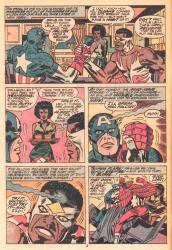
What, you thought I was kidding?
Later on, Henry Kissinger tells them to call him “Henny.” Some nights, Henny hits the bar and orders two Thug Passions. He pours one out for the homey Tupac and tosses the other back like it was nothing.
There’s so much to love about this series. Leila is awesome, but has disappeared down the same black hole as Glory Grant. I’d love to see her show up again, since last I remember, she was in Priest’s Cap & Falcon. I’ve talked about Kirby here, here, and here.
Jack Kirby is like Darwyn Cooke for me. I love them, but the work doesn’t exactly hit every month, so I tend to forget exactly how much I love them. And then I find, or remember, something they did and I realize that I’m a huge stan all over again.
Big ups to Chris from FBB for sparking this post thanks to an offhand image link and hilarious discussion.

Black History Month 09: Black Race-r
February 9th, 2008 Posted by david brothers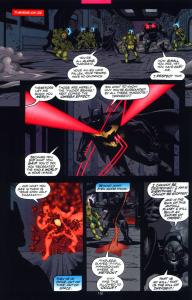
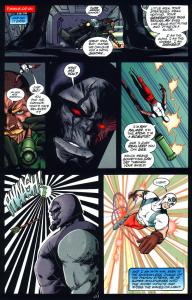
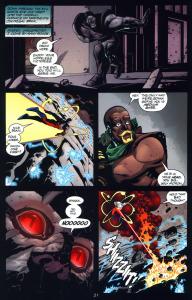
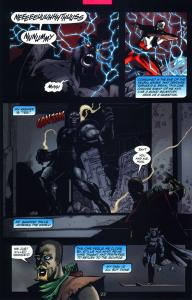
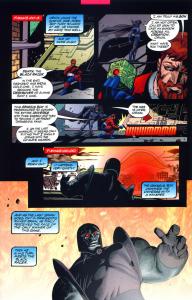
from dc comics’s JLA #14. grant morrison and howard porter on words/art.
Unseen. Unexpected. I come by many roads.
–Black RacerWe all know that DC sucked at repping black characters until the ’80s, while Marvel was all up in your face by the mid-70s. But, you want to know about “unexpected?” Let me give you a list.
Gabriel Jones, Black Panther, Flippa Dippa, Vykin the Black, Black Racer, Sam “Falcon” Wilson, Princess Zanda, and Mr. Miracle.
That’s eight black characters, right? Spread out over maybe fifteen years from the first to the last. Every single one a Jack Kirby creation.
The man may not have been the greatest with names (Black Racer, Vykin the Black, Black Panther) but he had a sick visual style and a willingness to throw black characters into his books with no problem at all. His characters have legs, too. Four of these characters are still players to this day (Falcon, Miracle, Panther, Racer), Gabriel Jones appeared in the 65th Anniversary issue of Captain America (with no lines, sadly), Vykin bit the bullet with Death of the New Gods, and Zanda had a good cameo in Black Panther where she was described as the “Paris Hilton of Africa.”
Well, I guess Flippa Dippa gets no love, but that’s just because he’s too awesome for anyone to write.
But really, eight fun black characters? Eight black characters with different origins, various abilities, all without falling into the trap of “Oh, he isn’t a stereotype!” or “He’s from the hood!” Fully realized, treated as equals, and completely interesting. It’s good stuff.

It’s been a long time…
October 18th, 2007 Posted by david brothersI have been fairly quiet in the past few weeks, haven’t I? I’ve got good reasons for it, I swear. In fact, I’ve got three good reasons– Heavenly Sword, Folklore, and SOCOM: Tactical Strike.
No, I didn’t pull a Joe Mad. I wrote the strategy guides for those games. This may come as a surprise, but writing strategy guides, among other responsibilities, tends to suck all the drive out of writing for fun! Plus, I’ve felt like sleeping for a week and man is it hard to write when you’re passed out.
I’ve got some breathing room, now, and my new project (secret!) involves very little writing, so I plan to come back in full force. I need to talk about why Frank Miller really hasn’t fallen off, why Jack Kirby’s New Gods saga has quickly turned into one of my most favorite story arcs (and I’m not even done with it!), and tons of other things. I figure I should talk about black people and comics, too, I guess. Is that my shtick yet?
We’ll see how it goes, but don’t call it a comeback! Actual words next time, I promise.

Long Live the King
August 28th, 2007 Posted by Hoatzin“It was then that I came to realize what a powerful and ever-contemporary art form “comics” is, and how important it is to keep the medium ever flexible and sustaining. This is the attitude at National Periodicals. This is the place to be, in order to watch the medium lock into into our turbulent times and fish for the future. For in that future, comics should be bigger than ever and the forerunner of newer and more stimulating trends. Carmine Infantino will tell you that. As National’s Editorial Director and a great pro himself, the “look to the future” is often discussed between us when my routine is straightened out. In my opinion, this kind of thinking can only be a plus for the reader. When an outfit is constantly immersed in anti-static output, it is well worth working for on this end, and earns faithful readership and friends on the other.”
– Jack Kirby, from Superman’s Pal Jimmy Olsen #133, October 1970.
Happy birthday Jack, thank you for everything.

Happy birthday, King.
August 28th, 2007 Posted by david brothersIt’s Jack Kirby’s birthday, and this is my meager contribution to the doubtless outpouring of appreciation we’re going to see today.
Jack Kirby opened my eyes to stories that are more than binary good vs evil. His 4th World saga is about Freedom vs Slavery. Darkseid’s interest in conquering and gaining the Anti-Life Equation isn’t about destroying the world so much as it is about making all of reality submit to perfect order.
The Anti-Life Equation gives its wielder “the outside control of all living thought.” Free-thinking beings are replaced with automatons, their will submerged, destroyed, and replaced with that of Darkseid’s.
Apokoliptians prize servitude above all. In the post immediately previous to this one, Justeen does not want to kill Desaad and move into position to take over Darkseid’s spot– she wants to kill Desaad so that she can submit to Darkseid. “Your wish is my command” taken literally and on a macro level. In Simonson’s Orion, Kalibak mentions that discipline is prized on Apokolips. However, what he really means is blind, unquestioning obedience. You don’t get to decide and you barely get to be. You exist at the whim of another, and if he’d like you to be someone else, you will.
There is no individuality on Apokolips. There is only order, obedience, and slavery. Darkseid isn’t some cartoonish, mustache-twirling villain. He wants order.
There is something about life being defined as freedom (to act, to live, to love, to create) that just really speaks to me.
I wish I had more time, but I’ve got to get out of here.
I didn’t discover you until my 20s, but thanks for pushing the limits, Jack Kirby. You made comics better.


